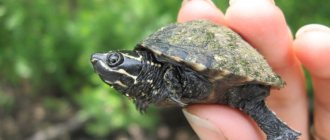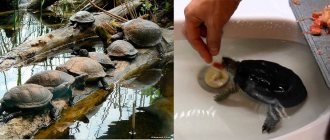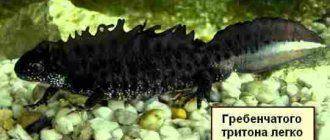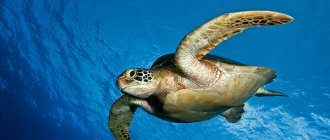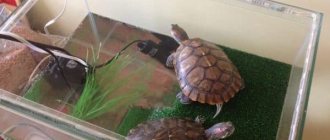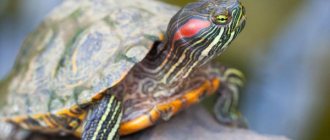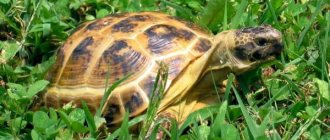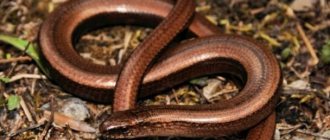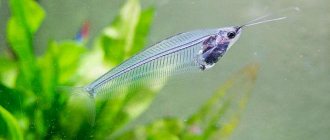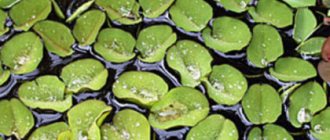This representative from the family of mud turtles has long settled in amateur aquariums for a long time. The reptile is unpretentious, has a modest size and does not require complex care, which is why it is popular in many countries. Calm, but not always peaceful, the musk turtle makes a wonderful pet that can live in captivity for more than 20 years.
Habitat
The habitat of common musk turtles is the silted reservoirs of the eastern and southeastern parts of the United States; they can also be found in southeastern Canada. The animal’s lifestyle is exclusively aquatic, so there are some specimens overgrown with algae.
The musk turtle spends almost all its waking hours in search of food, slowly moving along the bottom of the reservoir in which it lives, but at the same time it can swim quite well. This species of animal leaves the water expanses extremely rarely, mainly only to lay eggs or during precipitation. The time of greatest activity is twilight and night.
From time to time, musk turtles can be seen on the surface, when they expose their shells to the warm rays of the sun and bask, sometimes they even climb onto branches leaning towards the water, and in case of the slightest danger they promptly tip back into a safe body of water.
During the colder months of the year, this species of turtle spends at the bottom of the reservoir, burrowing deep into the silt. If for some reason the reservoir dries up, the turtles go in search of a new shelter; at such moments they can be found even in the snow.
More about them
Its “emissions” are directly related to the state of the animal: fear, panic, anger - all this provokes the release of yellow viscous, sharp-smelling mucus produced by special receptors. In the animal’s historical homeland, the USA, the turtle even received the derogatory nickname “Smelly Jim.” Meanwhile, in captivity, or rather at home, in a friendly artificial environment, when the turtle is treated well, taken care of and protected from any troubles, the animal does not need “aromatic attacks” at all, so good owners They know about possible troubles only theoretically .
External description
The sharp, persistent and unpleasant musky odor released by turtles at the moment of danger from the glands located under the shell gave the name to this subspecies. The local population simply calls them “stinkers” or “Stinky Jim.”
Despite the ability to swim well, it spends most of its time slowly moving along the bottom of the reservoir in search of food.
The carapace in this subspecies of turtles has an oblong oval shape, with an average length of about 8-10 cm, extremely rarely, in large individuals it can reach a maximum of 14 cm. Young representatives of musk turtles also have 3 longitudinal ridges. The plastron, movably connected to the main part in the anterior lobe, also has an oval shape, small size, as well as an inconspicuous ligament and 11 scutes. But, despite the movable joint, the range of movements in this part of the musk turtle is extremely limited, therefore, unlike their locking counterparts, they are unable to close the front hole.
The color of the head and neck of musk turtles is dull, dirty brown with a light pattern in the form of stripes.
A shortened plastron, a blunted crest, an elongated tail and the absence of spiny scales on the inside of the hind legs distinguish males from females. By the way, the scales, which were previously called the “chirp organ,” help the male hold his partner in place during mating.
A similar name, still often found in popular literature, scales earned their name thanks to the sound they make when they rub against each other with their limbs bent. The sound produced at the same time is very reminiscent of a bird chirping or the roulades of a cricket. The long and mobile neck of the common musk turtle allows it not only to reach its own hind legs, but also to quickly bite an unwary owner who dares to pick it up.
The musk turtle is distinguished from other types of turtles by small wart-like growths located on the neck and lower jaw.
Basic information about musk turtles
The homeland of these reptiles is the USA, but they have spread not only to the southeastern part of the States, but are also found in Canada. Turtles choose reservoirs with fresh water, sandy or muddy bottoms as their habitat. They spend most of their lives in water, and some reptiles are covered with a thick layer of algae. They are more active in the evenings and at night, at which time they slowly explore the bottom of the reservoir, looking for something edible.
Musk turtles are small representatives of their order; the average size of their oval carapace is 8-10 cm. Large (up to 14 cm) reptiles are rarely found. Juveniles have 3 longitudinal ridges on their armored shield. It is almost impossible to distinguish a male from a female among young animals, but in mature reptiles it is not difficult. Males have a shortened plastron, a long tail, and spine-like scales covering the inner surface of the hind limbs.
The main diet of turtles consists of small fish, mollusks, insects and plants. But they also do not disdain to taste carrion, which makes reptiles excellent orderlies of reservoirs. Individuals mate only in an aquatic environment, and lay eggs in holes; this occurs from April to the first summer month. Egg maturation lasts from 8 to 14 weeks, but this requires a certain air temperature - from 25° to 29°C.
Despite their modest size and harmless appearance, musk turtles are quite warlike reptiles. If you catch such an individual from a reservoir, it will break out in every possible way, bite, and scratch. In addition, it has another protective agent - musk glands, which emit a pungent odor in times of danger. In captivity, these animals live about 2 decades or longer.
Natural enemies
All turtles have strong armor, but, oddly enough, it does not guarantee their complete safety - the threat comes from a considerable number of enemies living in water and on land. The biggest blame for the extermination of reptiles lies with people who hunt turtles for their eggs, meat, beautiful shells, and sometimes just out of boredom.
Beasts of Prey
Wild big cats and foxes have become adept at splitting strong carapaces, throwing turtles from a height onto rocks . The jaguar, for example, so carefully (according to eyewitnesses) removes the reptile from its shell, as if it were wielding a thin sharp blade rather than claws. At the same time, the predator is rarely satisfied with one turtle, but immediately turns several on its back, choosing a flat (without vegetation) area. On such a cutting board, the reptile cannot catch on anything, stand up and crawl away.
Feathered predators
Large birds lift musk turtles into the sky and from there drop them onto rocks to peck the contents out of their cracked shells. Even crows prey on small reptiles, which should be taken into account when keeping turtles outdoors. It is better to cover the enclosure with a net or keep an eye on the pet when it crawls out to bask.
Feeding
The natural diet of this reptile is quite varied: crustaceans, mollusks, small fish, insects, aquatic plants, carrion. In an aquarium or aquaterrarium, a musk turtle can eat shrimp, mussels, snails, bloodworms, earthworms, fish fillets, crickets, cockroaches, and plants (which they don’t really like). You should not deny them dry turtle food. To avoid water contamination, it is recommended to feed turtles on their own, or in a specially designated area.
Young turtles are not averse to profiting from aquarium fish such as guppies, zebrafish, and rasboras. Therefore, they are not suitable for proximity to fish. Feeding adults - 2-3 times a week in such portions that the animal eats everything, but you should not overfeed. Even turtles can become obese.
Hunting instinct
The reptile has a hunting instinct. They will not miss their prey. The aquaterrarium is filled with living creatures along with the turtles that they can feed on. Small fish and snails are suitable. The latter are considered a delicacy and are eaten directly with the shell. Calcium is obtained from it.
Creating conditions for hunting will benefit the pet and relieve the blues and sedentary lifestyle.
Photo gallery of musk turtles:
Conditions of detention
For 1-3 turtles you will need an aquarium with a volume of at least 60 liters, filled with water to a level of 15 cm, with a total tank height of 25 cm. Place stones and driftwood in the nursery. For young turtles, you should leave some land and a small amount of water (they swim poorly). Both juveniles and adults climb snags to breathe in fresh air.
You need to install a high-quality filter in the aquarium; if there is none, replace 30% of the water yourself every week; with dirty water, you need to remove all droppings and dirt. Fresh water should have the same parameters as “old” water (temperature, acidity, hardness). Running tap water steeped for several days will also work.
Plants are not required to be installed. It is not necessary to heat aquarium water if the temperature in the tank is constant (20-26 degrees). Young turtles need an ultraviolet lamp, which reduces the risk of rickets. When the water temperature drops to 8-10 degrees, the musk turtle refuses to eat; in winter it is rarely fed. For 1 male you need to house 2 females.
Nutrition
Experienced turtle owners say: their pets need a separate “dining room”. You already know that musk turtles are dirty. So, after eating, they defecate almost immediately. Therefore, so that keeping pets does not cause you unnecessary trouble in cleaning the “premises”, place your pet in another aquarium while eating.
As for the menu, musk turtles do not give particular preference to any food. However, the more varied the menu, the more beneficial it is for the health of your charges. So, what's on the turtle menu :
- fish fry,
- crustaceans,
- earthworms,
- snails (together with shells),
- squid pieces,
- lean beef,
- boiled chicken meat,
- edible plants,
- crushed egg shells (calcium is needed for the strength of the shell).
You can purchase ready-made food for your pet, the price of which is sometimes high. For example, “ReptoDelica Snack” with daphnia costs 512 rubles, and “Raffy Baby-Gran” in the form of granules costs from 299 rubles.
How does reproduction occur?
At about a year old, the common musk turtle reaches sexual maturity. The mating process takes place in water; after fertilization, the female can remain fertile for about four years. The clutch, usually consisting of 2-7 eggs, occurs in the spring-summer period, from April to July. The eggs are covered with a fragile hard shell, the female places them in a small self-dug hole in the ground or in a natural depression; there are often cases when they do not bother themselves with digging nests, leaving the future offspring simply on the surface.
The eggs mature in 2-3.5 months, the optimal ambient temperature should be in the range of 25-29⁰ C. The hatched turtles grow quite quickly.
This subspecies of turtles has a high reproduction rate, so the threat of extinction does not hang over them.
Arrangement of a land island
Since these turtles are aquatic inhabitants and breathe underwater with their tongues, they do not, like other reptiles, need dry land to rest. They only need a narrow coastal strip to leave offspring. You can separate the water and the shore using a glass plate, an artificial embankment of sand or brickwork. On land, a container with low sides is installed, filled with a layer of sand, which should be pre-rinsed.
Breeders from Central Europe often move their charges to small outdoor ponds for the summer; such a habitat is as close as possible to natural conditions. A group of reptiles requires a fairly voluminous tank - this is the only way the inhabitants will not compete for food and territory.
In a terrarium, individuals can give birth throughout the year, but the mating period for these reptiles is not spring-summer if the turtles are kept outside. Musk turtles do not make any special movements during courtship, do not dance “mating dances,” and mating lasts from an hour to a day.
What do musk turtles eat?
These freshwater inhabitants can be called omnivorous and picky. They eat small fish, all kinds of small animals, and vegetation. And because of eating carrion, they received the honorary title of “reservoir orderly.”
When keeping a musk turtle in a terrarium, the owner faces a certain problem - due to the consumption of such food, the water in the tank becomes polluted very quickly. To prevent this from happening so quickly, experienced owners advise giving food to pets using tweezers or special needles on which pieces of food can be threaded.
And in order for the turtle to immediately understand the essence of such devices, it is worth starting to use them with the most delicious, tasty morsels and first holding them near the reptile’s face. Turtles adapt to them quite quickly. If the owner places small fish in an aquaterrarium, then it is worth remembering that the reptile will only consider them as food. Young individuals hunt for them especially actively.
Additional Information
One of the most unusual and interesting features of common musk turtles is the ability to stay under water for up to several months, breathing using their tongue. Nature has endowed some animals with special sinuses to absorb oxygen from water, and some have learned to breathe through their skin.
Research aimed at finding an organ that helps musk turtles with underwater breathing has been going on for quite some time, and now it has finally been found. It turned out that these reptiles acquired this ability through language.
In this case, oxygen is absorbed directly from the water thanks to the tubercles located on it. Research observations have shown that after obtaining food on land, young individuals always drag it under water, since otherwise they simply cannot eat it. It's all about the weakness and short length of their tongue, which is not suitable for swallowing and pushing food. Further research has proven that functionally this organ performs functions different from other animals.
TWO-CLAWED PIG-FOOLED WATER TURTLE IN THE AQUARIUM - MAINTENANCE AND CARE.
CHINESE TRIONIX - FAR EASTERN TURTLE CONTENTS AND CARE PHOTO.
SWAMP TURTLE CONTENTS FEEDING CARE DESCRIPTION BREEDING PHOTO VIDEO.
Data
To paraphrase the words of a famous song, we can say: “The turtle can be a biter.” Moreover, not because of a bad life, but because of his aggressive and proud character. If you want to pick up a pet (especially a male) and he is not in the mood to communicate, you are taking a risk. Remember: he has a long neck, and he can grab you with his teeth when you don't expect it.
In general, keeping it in a comfortable aquarium and careful care makes the animal peaceful, and it can live a calm, measured life of 23 years.
